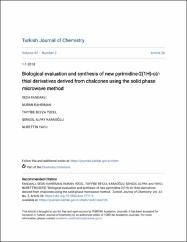Biological evaluation and synthesis of new pyrimidine-2(1H)-ol/-thiol derivatives derived from chalcones using the solid phase microwave method
Künye
Fandaklı, S., Kahriman, N., Yücel, T.B., Karaoğlu, Ş.A. & Yaylı, N. (2018). Biological evaluation and synthesis of new pyrimidine-2(1H)-ol/-thiol derivatives derived from chalcones using the solid phase microwave method. Turkish Journal of Chemistry, 42(2), 520-535. https://doi.org/10.3906/kim-1711-9Özet
Twenty-five new hydroxy- and methoxy-substituted 4,6-diarylpyrimidin-2(1H)-ol (20-34) and 4,6-diarylpyrimidine-2(1H)-thiol derivatives (35-44) were synthesized from the reaction of the corresponding 1,3-diaryl-2-propene-1-one compounds (1-19) with urea or thiourea using the solid-phase microwave method. All the new synthetic compounds (20-44) were evaluated with regard to their \g=a\-glucosidase activity. However, only compounds 22-25, 27, 31, 34, 35, 37, and 40 exhibited a greater inhibitory effect than standard acarbose. the IC50 values of the active compounds ranged between 2.36 and 13.34 mu M. the 25 new compounds were also screened for their in vitro pancreatic lipase activity and compounds 20-27 and 35-39 were found to be active. of these compounds 26, 27, and 39 exhibited the best antilipase activities at concentrations of 0.40 +/- 0.06, 0.26 +/- 0.07, and 0.29 +/- 0.026 mu M. All the new compounds (20-44) were evaluated for their in vitro antimicrobial activity for nine test microorganisms. Compounds 20-24 and 35-39 were determined to possess a significant broad spectrum against the gram-positive bacteria Escherichia faecalis, Staphylococcus aureus, and Bacillus cereus among the tested bacterial agents. Compounds 20-24 and 35-39 exhibit the best activity against Mycobacterium smegmatis, with minimum inhibitory concentrations of 62.5-500 mu g/mL, indicating their potential use as antituberculous agents.


















